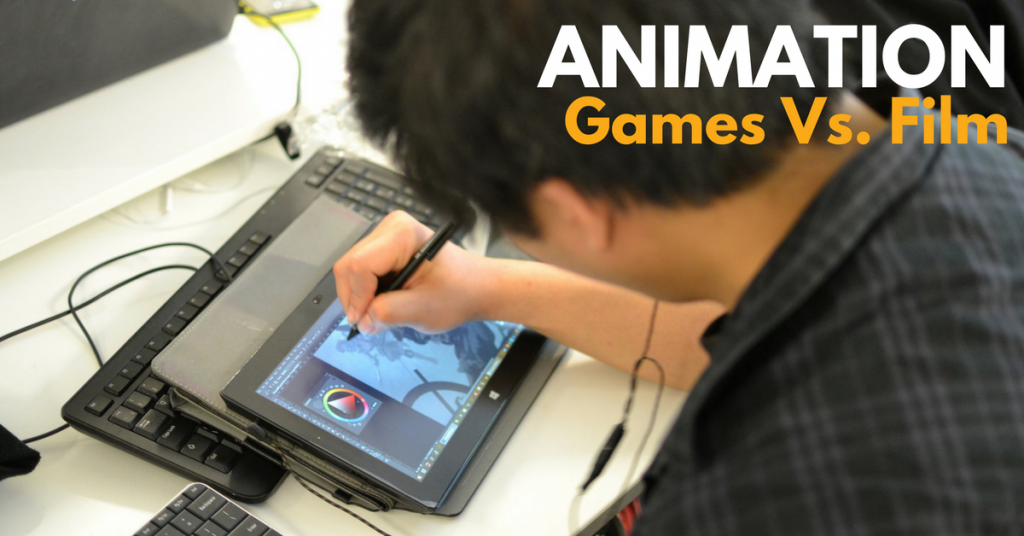
At first glance, you might think that animating for film and animating for games are very similar. When you look in more detail though, you’ll see that the two skills are very different in practice. One of the main differences is that animated films are viewed by an audience who ‘sit back’ and games are designed to be actively played – the gamer needs to interact with the environment. Let’s take a deeper look at some of the differences:
Rich Animated Environments
First of all, as animators we need to think about the environment we’re creating. The three-dimensional environment produced by an animator for film is far less complex that the one designed for a game. For a movie, the animator only needs to create what happens in the line of sight for the audience. The animator may have to create a room and create characters but he/she doesn’t necessarily need to worry about how the characters will interact with all the elements in the room – often they may be interacting with each-other only.
Games are a bit different though. They’ve become so powerful and immersive that the animator needs to think about all the objects in a room and how the characters might interact with them. For example, turning on and off lights, picking up objects, opening doors…The list is pretty much endless!
Creating a rich environment is a critical part of animation for both film and games. When you get it right, the project will be much more successful.
Camera Angles
Camera angles are another difference – once you hit play on a movie you can’t change the angle you view the film. This makes animating movies a little more straight forward. All the best animated movies take the time to plan the animation which makes them so enjoyable to watch. A game animator’s job is different and they need to create a full range of view and motion. The animation must encompass full 360-degree views of the environment. In most games, you can change camera angle from first person to over the shoulder etc or you can look around the environment so there’s a lot of detail and perspectives to consider!
Rendering
What is rendering? Rendering is taking all the components and variables in each frame; lighting, texture, colour etc and building them into a final viewable result in a complete animated graphic.
Film animators don’t normally need to consider power and performance. However, the power of the console being used by the gamer will have an effect on rendering the animation and this needs to be taken into consideration. As you move through a game the rendering engine is continuously creating animation based on a several variables such as; character data, camera angle, environment. You’ll want to be able to render as much detail as possible. The computer needs to be fast and able to render as quickly as the player makes changes in the game so this is where power comes into play. On the other hand, film animators can let the rendering process take as much time as necessary to produce the final movie for viewing.
Artificial Intelligence versus Scripted Motion
Artificial Intelligence (AI) engines are now common place in game dev environments which help to determine in-game character behaviour. This feature makes games smarter and game characters become ‘alive’ in their own way, moving not in ways predetermined by the animator but rather reacting to stimuli and developing their own path. Characters are designed, built and animated and the game engine then ‘animates’ them in whatever way the gameplay dictates. On the flip side of this, animators for film must always maintain strict control over the characters, with the sole function to make sure they enact a script precisely.
Time To Create
Another key area where animating for film and games differ is the amount of time animators have to work on each one. Generally speaking, animators working on games have far less time than animators for film to complete their animation. On longer, feature length animated films, animators can have months to perfect a single shot. In comparison, animators working in the games industry have a much quicker turnaround time. The overall animated work in a game may not be as perfect as what’s seen on the big screen, but the aim isn’t to create the best looking animation, it’s about ensuring the animation works well for the player.
Check out the videos below for a behind the scenes look at animating for a feature film and the role of animation working in tandem with gameplay for action games.
Animation Course
The animation industry in Ireland is booming and it’s a great time to learn some new skills!
If you’re interested in animation and want to learn more we have several courses ranging from Introduction to Animation courses, Springboard+ courses all the way up to a BA Degree in Animation.
If you want any more information why not drop along to one of our upcoming Open Events?
FOLLOW US